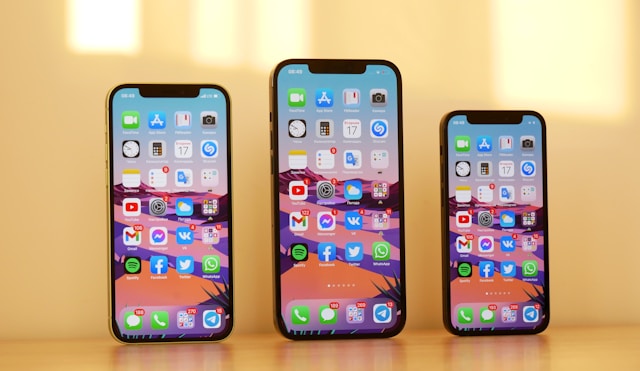Crafting a Corporate Website Design that Leaves a Lasting Impression
In today's digital age, a corporate website serves as the digital face of a company. It is often the first point of contact for potential customers, partners, and investors. Therefore, designing a corporate website that not only attracts visitors but also effectively communicates your brand's values, products, and services is important. In this article, we will discuss the topic of crafting a corporate website design that leaves a lasting impression.
Understanding the Purpose
Understanding the purpose of a corporate website is an important first step. Each purpose dictates a unique plan that caters to specific needs and objectives. For example, if the website serves as an informational hub for a technology company, the design may prioritize clear navigation to technical documentation, case studies, and product specifications. On the other hand, if it is a lead generation tool for a consulting firm, the design may emphasize compelling calls-to-action, such as contact forms and consultation requests. These calls-to-action need to be placed strategically placed throughout the site to encourage visitor engagement.
Similarly, a corporate website functioning as an e-commerce platform requires a design that facilitates seamless browsing and purchasing experiences. This entails implementing intuitive product categorization, robust search functionality, and secure checkout processes. By aligning the design with the website's purpose, businesses can effectively guide visitors toward desired actions. Whether it is acquiring information, generating leads, or completing transactions, understanding the purpose of your website can ultimately maximize the website's value and impact.

User-Centric Design
User-centric design is not just about creating a visually appealing website. It is about crafting an experience tailored to the needs and expectations of the target audience. For example, if the corporate website caters to a diverse demographic, the design should accommodate various languages and cultural sensitivities. Implementing features like language selectors and region-specific content can enhance accessibility and engagement for users worldwide.
Furthermore, user-centric design extends beyond initial website development. It involves ongoing refinement based on user feedback and behavioral analytics. For example, if analytics reveal that a significant portion of visitors drop off at the checkout process, simplifying the checkout form may help alleviate friction points and improve conversion rates over time. By prioritizing user needs and iteratively refining the design based on data-driven insights, businesses can create a corporate website that fosters meaningful interactions and drives tangible business outcomes.
Clean and Intuitive Navigation
Clean and intuitive navigation is essential for ensuring a seamless user experience and maximizing engagement on a corporate website. For example, consider a financial services company's website that offers a wide range of products and services. By categorizing these offerings into clear sections within the navigation menu, such as “Personal Loan”, “Product Financing”, and “Investment Services”, users can quickly locate relevant information based on their needs and interests. Moreover, incorporating interactive elements like dropdown menus or mega menus can further streamline navigation, providing users with additional context and options without overwhelming them with too much information at once.
Furthermore, optimizing navigation for mobile devices is paramount in today's mobile-first landscape. With a growing number of users accessing websites on smartphones and tablets, ensuring that navigation remains intuitive and user-friendly across all screen sizes is crucial. Additionally, prioritizing key actions and content within the mobile navigation menu can help users accomplish their goals efficiently. By prioritizing clean and intuitive navigation, corporate websites can enhance usability, foster engagement, and ultimately drive conversions across all devices.
Mobile Responsiveness
Mobile responsiveness is not merely a feature but a necessity in today's digital landscape. Consider a corporate website for a fashion retailer. A mobile user browsing the latest collection on their smartphone expects the same level of visual appeal and functionality as a desktop user. By employing responsive design techniques, the website can automatically adjust its layout and content to fit the screen size and resolution of any device. This ensures that users can easily navigate the website, browse products, and complete transactions on smartphones, tablets, or desktops without encountering any usability issues. In essence, mobile responsiveness is no longer a luxury but a fundamental requirement for corporate websites aiming to reach and engage with their target audience effectively.

Brand Consistency
Brand consistency is crucial in corporate website design as it serves as a reflection of the company's identity and values. By incorporating the company's signature color palette, modern typography, and cutting-edge imagery throughout the website, visitors immediately recognize the brand's identity. They can feel a sense of familiarity and trust. Consistency in tone of voice further reinforces the brand's personality, whether it is authoritative and professional for B2B audiences or friendly for consumer-facing interactions. By maintaining brand consistency across all touchpoints, from the website to social media profiles and marketing materials, companies can strengthen brand recognition and build credibility.
Moreover, brand consistency extends beyond visual elements to encompass the overall user experience and messaging. For example, a luxury automotive manufacturer's website not only showcases high-quality imagery but also delivers a premium browsing experience reflective of the brand's commitment to excellence. From the moment users land on the homepage to the checkout process, every interaction reinforces the brand's values of sophistication and performance. By ensuring consistency in design and user experience, corporate websites can effectively differentiate themselves in competitive markets, ultimately driving customer loyalty.
Compelling Visuals
Compelling visuals are the cornerstone of a memorable corporate website design. Visuals are capable of leaving a lasting impression on visitors. Consider a lifestyle brand specializing in outdoor adventure gear. Immersive imagery showcasing beautiful landscapes, adventurous activities, and happy customers can captivate the audience and evoke a sense of excitement. Incorporating videos that tell compelling stories about the brand's mission, values, and products further enhances engagement and fosters emotional connections with the audience. However, it is crucial to maintain a balance between visual appeal and usability. Images and videos must complement the content without overshadowing it. By strategically integrating visuals that align with the brand's narrative and resonate with the target audience, corporate websites can effectively communicate their unique identity and evoke desired emotions.
Moreover, visual storytelling goes beyond aesthetics. It can also convey complex information in a digestible and engaging format. For example, an educational institution's website may use infographics and charts to illustrate academic achievements and research breakthroughs. By presenting data visually, the website can facilitate informed decision-making for prospective students and parents. By leveraging compelling visuals to enhance storytelling and convey information effectively, corporate websites can create immersive experiences that resonate with their audience and drive desired actions.
Content Strategy
A robust content strategy is the backbone of a successful corporate website. It can guide the creation and dissemination of relevant and valuable information to the target audience. Consider a software company specializing in project management solutions. A well-crafted content strategy may include blog posts offering practical tips for improving team productivity, case studies highlighting real-world success stories, and video tutorials demonstrating the software's features. By addressing common pain points, their website not only attracts visitors but also positions the company as a trusted authority in its industry. Moreover, aligning content with the buyer's journey ensures that users receive the right information at each stage of their decision-making process.
Furthermore, a content strategy extends beyond textual content to encompass multimedia elements that enhance engagement and comprehension. For instance, an e-commerce retailer's website may feature product demonstration videos, customer testimonials, and user-generated content to showcase the quality of its offerings. By leveraging multimedia content, the website provides a more immersive experience for users. Additionally, optimizing content for search engines through keyword research and on-page optimization techniques helps improve visibility and attract organic traffic to the website. By implementing a comprehensive content strategy that encompasses various formats and channels, corporate websites can effectively engage and inspire their audience.

Accessibility
In today's digital age, ensuring accessibility in corporate website design is about fostering inclusivity and ensuring equal access to information for all users. Implementing accessible design practices, such as providing alternative text for images, keyboard navigation, and compatibility with screen readers, is essential for creating a barrier-free browsing experience. For example, individuals with visual impairments rely on screen readers to interpret website content. Descriptive alternative text for images allows them to understand the context and meaning of visual elements. Similarly, enabling keyboard navigation features ensures that users with mobility impairments can navigate the website efficiently without relying on a mouse. By prioritizing accessibility in corporate website design, businesses demonstrate their commitment to equity and inclusion, ultimately fostering positive relationships with all users.
Performance Optimization
In today's fast-paced digital world, where attention spans are short and expectations for instant gratification are high, the speed at which a corporate website loads can make or break the user experience. A slow-loading website not only frustrates visitors but also risks losing potential customers and damaging the company's reputation. Therefore, performance optimization is a necessity for corporate website design. Website owners should optimize images, minify code, leverage browser caching, and select a reliable hosting provider to improve the efficiency of their websites. Moreover, beyond enhancing user experience, performance optimization also plays a critical role in search engine rankings. Google prioritizes fast-loading websites in its algorithms. By investing in performance optimization measures, businesses can ensure that their corporate website remains competitive, user-friendly, and accessible to visitors.
Security Measures
In an era where cybersecurity threats loom large, implementing robust security measures is imperative to safeguard both the corporate website and the sensitive information it houses. With data breaches becoming increasingly common, ensuring the integrity and confidentiality of user data is paramount to maintaining trust and credibility. SSL encryption, for instance, encrypts data transmitted between the user's browser and the website's server. It can prevent unauthorized access and interception of sensitive information such as login credentials or payment details. Regularly updating software, including content management systems (CMS) and plugins, is equally crucial as it patches known vulnerabilities and strengthens defenses against potential exploits.
Moreover, employing strong authentication measures adds an extra layer of protection against unauthorized access to the corporate website. Implementing measures like multi-factor authentication (MFA) or CAPTCHA challenges helps verify the identity of users and mitigates the risk of brute-force attacks or unauthorized login attempts. Additionally, conducting regular security audits and penetration testing can help identify and address potential vulnerabilities before they are exploited by malicious actors. By prioritizing security measures in corporate website design, businesses can mitigate risks and uphold their commitment to maintaining a secure online environment for users.

Continuous Improvement
Continuous improvement is vital in corporate website design. Ongoing monitoring of performance metrics and collection of user feedback are required for enhancement. This involves not only monitoring website performance metrics, such as page load times, bounce rates, and conversion rates but also actively seeking feedback from users to understand their evolving needs. By leveraging user feedback and analytics insights, businesses can identify pain points, optimize user journeys, and implement enhancements to enhance the overall user experience.
Furthermore, staying abreast of industry trends and emerging technologies is essential for driving innovation and maintaining relevance in a competitive marketplace. Businesses can adopt emerging technologies and integrate cutting-edge features to continually evolve their website. By embracing a culture of continuous improvement and innovation, businesses can future-proof their corporate website, ensuring that it remains a valuable asset that drives engagement and fosters brand loyalty.
Conclusion
In conclusion, designing a corporate website that effectively communicates your brand's values and engages users requires careful planning and a user-centric approach. By focusing on the various aspects mentioned above, you can create a corporate website that leaves a lasting impression on visitors and drives business growth. So, what are you waiting for? Start to explore corporate website design with Appnicorn today!